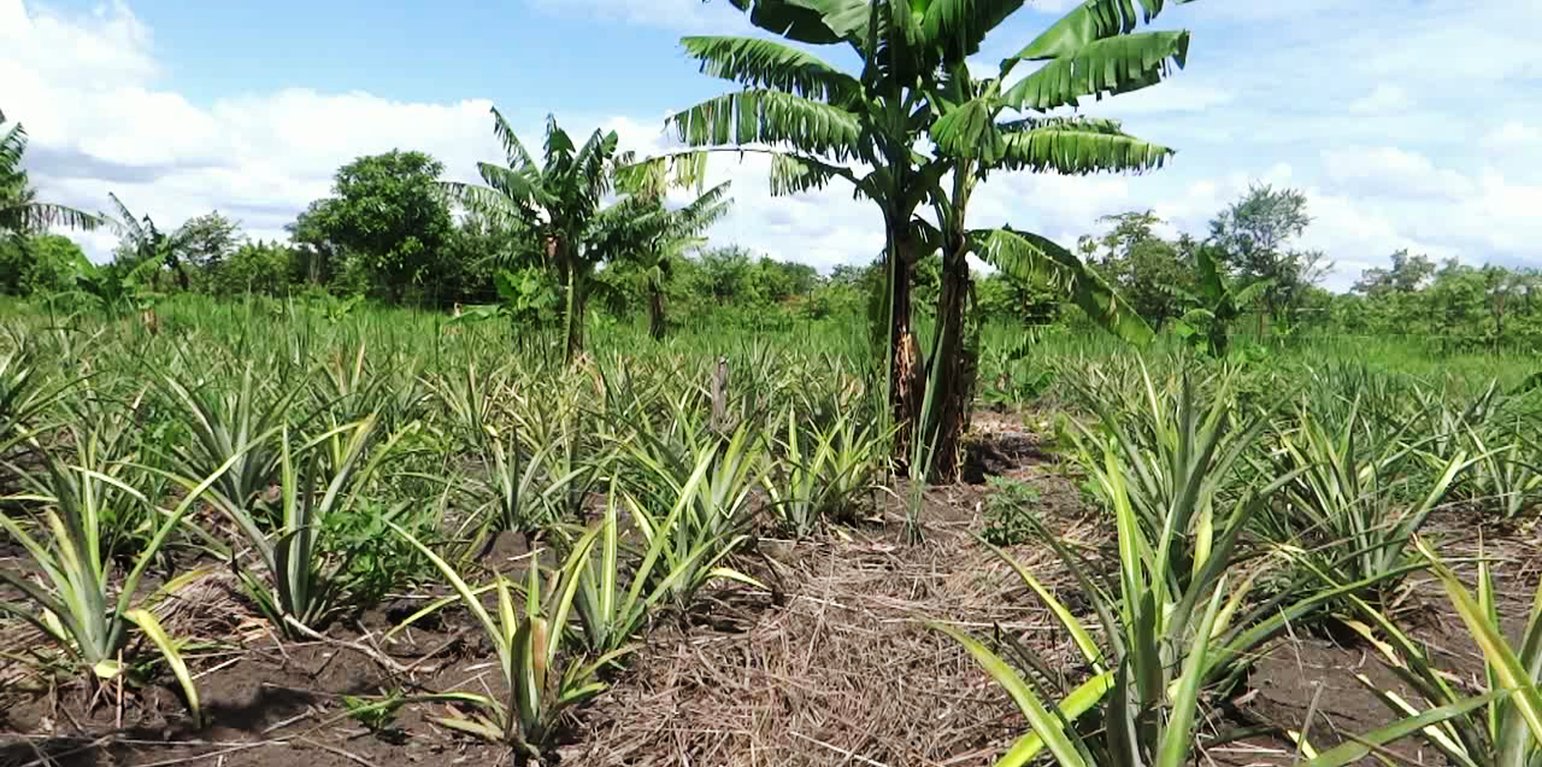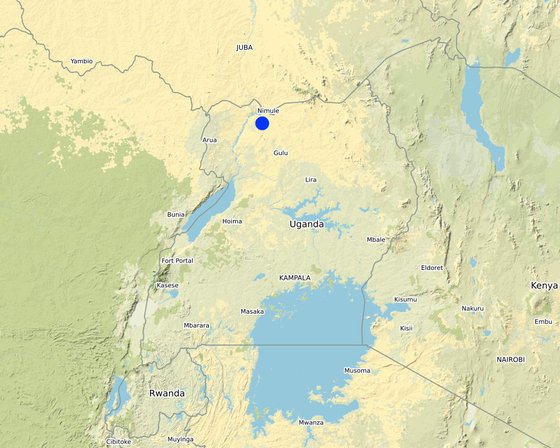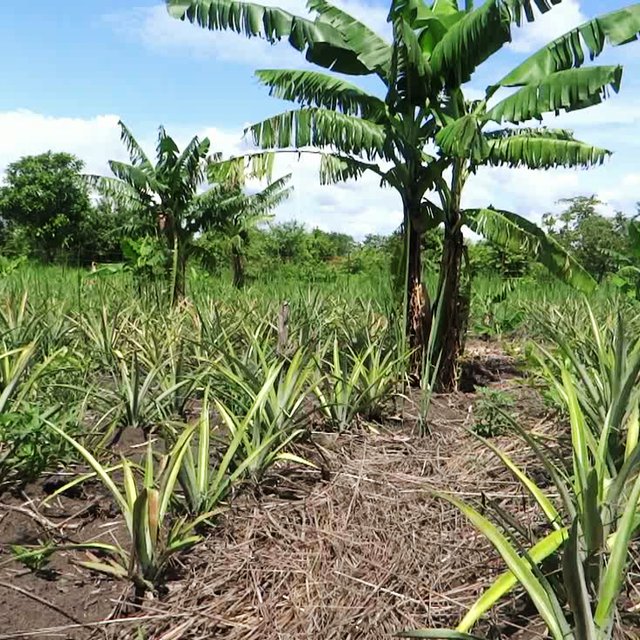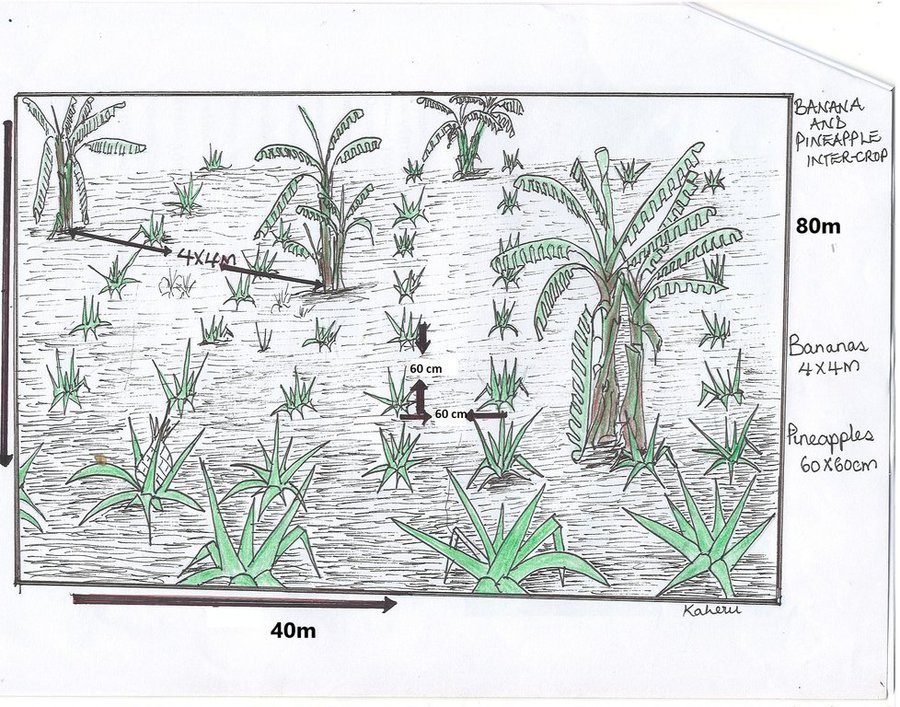



Intercropping is the practice of growing two or more crops in close proximity. Traditional growing of many annual crops like soybean, groundnut, beans and vegetables like tomatoes and onions as intercrop in banana plantations increased the risk of soil erosion in the agricultural land of Uganda. These crops require more cultural farming practices that enhance the removal of top soil layer. Therefore, the intercropping system of banana with pineapple is practiced for optimum land utilization and control of soil loss. As these crops are perennial, they require less soil and crop management practices as compared to annual crops.
The banana pineapple intercrop pattern was established with the aim of making effective use of available resources, optimum land utilisation, and sustainable production. The technology was established in 2016. The area experiences a bimodal rainfall pattern with annual rainfall ranging between 700mm-1200mm. The farm lies on 0.32 ha of land located in the valley and from observations the soils on this farm could be classified as clay loams. The bananas grown are a local Musa spp. Bananas are planted at a spacing of 4 m×4 m from row to row and plant to plant and are taken as the major crop in this technology. The pineapples are an improved variety (smooth cayenne) which is yellow cylindrical and juicy, planted at a spacing of 60 cm × 60 cm inter and intra row and planted at a distance of 75cm from a banana plant.
Establishment activities for the banana plantation were bush clearing, ploughing, excavation of 60cm×60cm planting holes, animal manure application (obtained from the owner’s farm) mixed with top soil and used to fill half the planting holes and, lastly planting the banana suckers. After a year the farmer introduced pineapples which, involved digging planting holes, the application of animal manure and the planting of pineapple suckers. Planting of bananas took 2 man days whereas planting of pineapples took 4 man days. Maintenance activities included regular spraying of pineapples with pesticide and fungicides, pruning, desuckering and thinning of bananas, weeding and watering.
According to the farmer, inter-cropping bananas with high value crops such as pineapples increases his income while ensuring food security. It reduces his vulnerability to climate change since the pineapples act as soil cover and therefore increase soil moisture retention. “With this technology we reduce management costs since we do not need to weed, spray, apply manure on 2 separate gardens” he says. In addition inter-cropping minimizes risks associated with growing a single crop and ensures stable subsistence food availability and possible income. It also promotes the effective use of available resources, increased crop productivity and soil erosion control.
The disadvantages of the technology include:
- Increased competition for water and nutrients
- Weeding in banana pineapple inter crops becomes challenging since pineapples have a prickly leaf
- During establishment of the bananas and pineapples plantations trees are cut down to create space for the crops and this leads to deforestation
- Pineapples habour pests and diseases that may cause damage to bananas
- This intercrop requires a high level of skills from the farmer

Localização: Anzoa Adjumani District, Northern Uganda, Uganda
Nº de sites de tecnologia analisados: Local único
Difusão da tecnologia: Uniformemente difundida numa área (approx. < 0,1 km2 (10 ha))
Data da implementação: 2016
Tipo de introdução






| Especifique a entrada | Unidade | Quantidade | Custos por unidade (UGX) | Custos totais por entrada (UGX) | % dos custos arcados pelos usuários da terra |
| Mão-de-obra | |||||
| Bush clearing | people | 14,0 | 6600,0 | 92400,0 | 100,0 |
| Excavating planting holes | hole | 100,0 | 1000,0 | 100000,0 | 100,0 |
| Application of manure | basket | 100,0 | 500,0 | 50000,0 | 100,0 |
| Planting | plant | 100,0 | 200,0 | 20000,0 | 100,0 |
| Equipamento | |||||
| Water pump | piece | 1,0 | 50000,0 | 50000,0 | 100,0 |
| Pangas | piece | 3,0 | 10000,0 | 30000,0 | 100,0 |
| Hoes | piece | 3,0 | 10000,0 | 30000,0 | 100,0 |
| Hose pipes | Roll | 1,0 | 100000,0 | 100000,0 | 100,0 |
| Jerricans | pc | 4,0 | 7000,0 | 28000,0 | 100,0 |
| Material vegetal | |||||
| Banana suckers | piece | 300,0 | 1500,0 | 450000,0 | 100,0 |
| Pineapple suckers | piece | 8000,0 | |||
| Fertilizantes e biocidas | |||||
| Animal manure | bgs | 20,0 | 15000,0 | 300000,0 | 100,0 |
| Custos totais para a implantação da tecnologia | 1'250'400.0 | ||||
| Especifique a entrada | Unidade | Quantidade | Custos por unidade (UGX) | Custos totais por entrada (UGX) | % dos custos arcados pelos usuários da terra |
| Mão-de-obra | |||||
| weeding | pp | 3,0 | 6600,0 | 19800,0 | 100,0 |
| watering | pp | 3,0 | 6600,0 | 19800,0 | 100,0 |
| spraying | knapsack | 3,0 | 3000,0 | 9000,0 | 100,0 |
| Fertilizantes e biocidas | |||||
| Pesticides | liters | 6,0 | 20000,0 | 120000,0 | |
| Custos totais para a manutenção da tecnologia | 168'600.0 | ||||
Application of manure on pineapples benefits the bananas. Since the intercrop was establish more bigger bunches of bananas are harvested, though records were not available
Pineapples act as a soil cover for the bananas hence reducing their vulnerability to droughts, thereby reducing on risk of crop failure
Workload reduces since weeding pineapples means weeding bananas too
The pineapple intercrop acts as a soil cover therefore increasing soil moisture retention